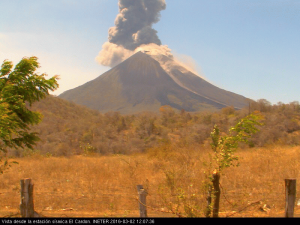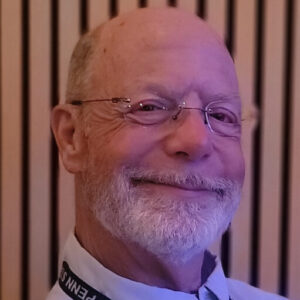
One of the many amazing things about staying in Managua is that not only are we living in the midst of one of the world’s most unstable seismic areas, we also have two active volcanoes nearby.
To our north, on the northern shore of Lake Managua (Managua is on the southern shore, about 50 kilometers away) is a beautiful cone-shaped volcano named Momotombo. I checked online for the meaning of the name but there were no results, so I’ll assume the name was intended to resemble the sounds of a volcano eruption, unless it’s ancient Mayan for “The Gods are angry again !” Until November of last year, Momotombo had not erupted since 1905.
Now, it seems Momotombo won’t shut up. It’s been erupting off and on since December, including two eruptions just a few days ago. After 110 years of relative calm, Momotombo has erupted 70 times in the past 14 weeks. As you can see in the photo above, Momotombo produces some ash along with lava that can be seen at night from a distance. The picture captures some pyroclastic flow, a current of hot gases and rock, down the side of the volcano.

Our other volcano, 20 kilometers to the south of Managua, is called Masaya. It looks more like a black pumice landfill than a volcano, but that’s because it has numerous craters and calderas that have all erupted in the recent past, piling up lava chunks and ruining its chances of looking like the picturesque and shapely Momotombo, which (at least for now) has only one crater.
My cousin Judy went with us a few weeks ago to look down into Masaya’s craters. Masaya has the distinction of being the only volcano in the Western hemisphere that you can drive up to the top of, get out, and look over a low wall right into its steaming depths (see previous post). Unknown to us at the time, there were two seething lava pools at the bottom of one of those craters. We couldn’t see them because of the noxious vapors rising out of the crater. Geologists became so concerned over Masaya’s increasing lava pool formation, accompanied by increases in heat and sulfur dioxide, that they closed off Masaya to tourists just a few days after we were there and it’s been closed ever since.
Lest anyone become concerned about our proximity to these volcanoes, be assured that they are not huge volcanoes and Managua is well outside of the range of damage they can do. One of our diversions at the hotel is to periodically check the volcano webcams to keep an eye on our two rambunctious neighbors.
Just another day on the Pacific “Ring of Fire”.

I have to rely on webcams to see the volcanoes. Neither one is visible from our hotel. I must have been a vulcanologist in a previous life, because I would love to directly see Momotombo erupt. Not many have that privilege (or perhaps I should call it a death wish? 🙂